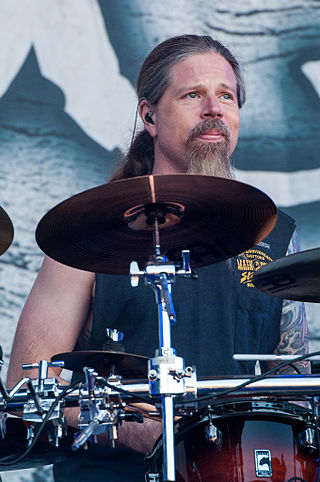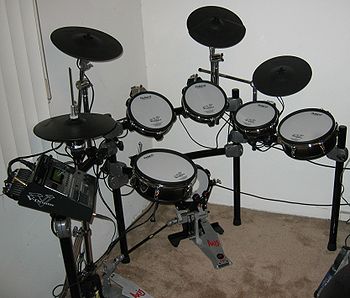
A drum kit is a collection of drums, cymbals, and sometimes other auxiliary percussion instruments set up to be played by one person. The drummer typically holds a pair of matching drumsticks, and uses their feet to operate hi-hat and bass drum pedals.

A drum machine is an electronic musical instrument that creates percussion sounds, drum beats, and patterns. Drum machines may imitate drum kits or other percussion instruments, or produce unique sounds, such as synthesized electronic tones. A drum machine often has pre-programmed beats and patterns for popular genres and styles, such as pop music, rock music, and dance music. Most modern drum machines made in the 2010s and 2020s also allow users to program their own rhythms and beats. Drum machines may create sounds using analog synthesis or play prerecorded samples.
General MIDI is a standardized specification for electronic musical instruments that respond to MIDI messages. GM was developed by the American MIDI Manufacturers Association (MMA) and the Japan MIDI Standards Committee (JMSC) and first published in 1991. The official specification is available in English from the MMA, bound together with the MIDI 1.0 specification, and in Japanese from the Association of Musical Electronic Industry (AMEI).

A digital piano is a type of electronic keyboard instrument designed to serve primarily as an alternative to the traditional acoustic piano, both in how it feels to play and in the sound it produces. Digital pianos use either synthesized emulation or recorded samples of an acoustic piano, which are played through one or more internal loudspeakers. They also incorporate weighted keys, which recreate the feel of an acoustic piano. Some digital pianos are designed to also look like an upright or grand piano. Others may be very simple, without a stand.

A drumhead or drum skin is a membrane stretched over one or both of the open ends of a drum. The drumhead is struck with sticks, mallets, or hands, so that it vibrates and the sound resonates through the drum.

Pearl Musical Instrument Company, simply known as Pearl, is a multinational corporation based in Japan with a wide range of products, predominantly percussion instruments.

A practice pad or drum pad, is a piece of equipment used by drummers and other percussionists to practice quietly, or to warm up before a performance.

Electronic drums are a modern electronic musical instrument, primarily designed to serve as an alternative to an acoustic drum kit. Electronic drums consist of an electronic sound module which produces the synthesized or sampled percussion sounds and a set of pads, usually constructed in a shape to resemble drums and cymbals, which are equipped with electronic sensors to send an electronic signal to the sound module which outputs a sound. Like acoustic drums, the pads are struck by drum sticks and they are played in a similar manner to an acoustic drum kit, albeit with some differences in the drumming experience.
The DTX range consists of electronic drum kits and percussion controllers manufactured by the Yamaha Corporation. They currently cover levels from entry-level to pro-range. DTX kits use sampling for their sounds, meaning each kit has built-in digital recordings of real drums, and cymbals. When the drum or cymbal pads are hit, the digital recordings are played back to replicate what is being played. On all kits, the sounds are editable – the pitch can be made higher or lower (tuned) and many other features. The higher the range of the DTX, the more functions there are editable.

Christopher James Adler is an American musician, best known as the founder and longtime drummer of heavy metal band Lamb of God from 1994 to 2019, and of Megadeth from 2015 to 2016.

The Roland TR-505 rhythm composer is a drum machine and MIDI sequencer released by Roland Corporation in 1986. It hails from the same family of drum machines as the Roland TR-909, TR-808, TR-707, TR-626 and TR-606. The drum kit includes basic rock drum sounds similar to those of the TR-707, plus a complement of Latin-style drum sounds similar to those of the TR-727

Simmons is an electronic drum brand, which originally was a pioneering British manufacturer of electronic drums. Founded in 1978 by Dave Simmons, it supplied electronic kits from 1980 to 1998. The drums' distinctive, electronic sound can be found on countless albums from the 1980s. The company closed in 1999 and the Simmons name is currently owned by Guitar Center.

The Simmons SDS 5, SDSV, or Simmons Drum Synthesizer was the first viable electronic replacement for acoustic drums. It was developed by Richard James Burgess and Dave Simmons, manufactured initially by Musicaid in Hatfield, UK, and commercially released in 1981. After Musicaid went bankrupt, Simmons set up a new manufacturing company under his name, Simmons.

An electronic drum module is an electronic or digital music device in an electronic drum kit that serves as the central processing unit and sound module. The drum module creates or produces the drum kit sounds or other sounds selected by the drummer. By itself, a drum module cannot play or sound drum beats. It only produces drum sounds when a performer strikes electronic drum pads or acoustic drum kit instruments that have electronic "triggers" attached to them. When the electronic drum pads or trigger-equipped instruments are struck, this sends a signal to the drum module, which produces the corresponding electronic drum sound. Even when drum pads and/or triggers are connected to a drum module, the drum module by itself does not make any audible sound. Like other electronic instruments such as the synthesizer, the drum module only outputs an electronic signal. The performer can hear this signal by connecting headphones to the drum module or by plugging the drum module into an amplifier and loudspeaker or PA system for audible practice or live performances. The drum module's output signal can also be patched into an audio console for concerts or sound recording. The nomenclature varies. For example, electronic drum modules are called "percussion sound modules" in the case of Roland Corporation, or sometimes simply modules. A common colloquial term for this device is drum brain..

Drum hardware is the set of parts of a drum or drum kit that are used to tension, position, and otherwise support the instruments themselves.

The Roland TR-707 Rhythm Composer is a drum machine released by Roland Corporation in 1985.
The Boss DR-220 Dr. Rhythm is a series of two budget-priced digital drum machines developed and manufactured by Boss Corporation beginning in 1985.

The Linn 9000 is an electronic musical instrument manufactured by Linn Electronics as the successor to the LinnDrum. It was introduced in 1984 at a list price of $5,000, and about 1100 units were produced.
The DrumIt Five is an electronic drum line produced by 2box, a Swedish company started by former employees of ddrum. The kit is based on tunable mesh drum heads, similar to Roland's V-Drum line. The focus of its design is to produce more natural sounds than are characteristic of most electronic drum kits on the market.















